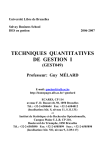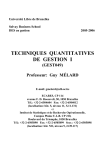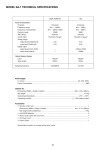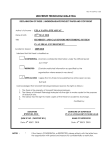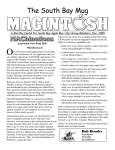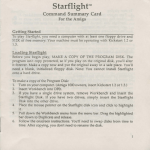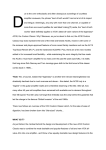Download Newsbreak April 2001 2
Transcript
NEWS BREAK MACINTOSH USERS GROUP, ONEONTA, NEW YORK April 2001 Volume 16, Number 3 APRIL MEETING: SHOULD YOU QUICKEN® YOUR LIFE? – TERRY HELSER *****NOTE OUR NEW LOCATION***** Join us on Tuesday, April 3rd (postponed from March 6th) at 7:30 PM in our new location, Physical Sciences building room 121 on the SUNY Oneonta campus. See map and directions. Professor Terry Helser will introduce us to Quicken 2001, the personal finance program, and to the Physical Science building’s new “smart classroom.” For more information, contact Terry Helser at 432-8123 or email us at [email protected]. NEEDED: USED CHILDREN’S SOFTWARE FOR KIDS WITH SPECIAL NEEDS Do you have children’s software gathering dust on a shelf? MUG ONE member Don Gersch will gladly accept donations of used kid’s software on floppies or CD-ROMs to be used by area children of all ages with developmental disabilities. He’s particularly interested in finding older Living Books titles. If you have children’s software (Mac or Windows) that you’re no longer using and would be willing to donate it to a good cause, contact Don at [email protected] or bring the software to the next MUG ONE meeting. POST OFFICE OFFERS FREE ENVELOPES FOR RECYCLING INK CARTRIDGES A display in the Oneonta Post Office dispenses free, postage paid envelopes for recycling empty inkjet printer cartridges. Cartridges need to be placed into their original packaging (or into the packaging for the replacement cartridge) and sealed into the clear, postage-paid envelope. Envelopes can be mailed from any mailbox. Many thanks to the local Post Office for making it so easy to recycle used inkjet cartridges. OS X (TEN) ARRIVES AT LONG LAST Well, the wait is finally over. OS X (ten), touted by Apple as “the world’s most advanced operating system”, began shipping on Saturday, March 24th. And it was worth the wait. Apple has generously provided MUG ONE with a copy of OS X. We’ve scheduled a full-fledged demonstration for our May 1st meeting. In the meantime, watch for a sneak preview, as well as a surprise or two, at the April 3rd meeting. – ELSA TRAVISANO MUG ONE OFFICERS FOR 2000-2001 Jay Manning, President email: [email protected] 607/433-1305 Elsa Travisano, Vice President email: [email protected] 607/433-2569 Terry Helser, Sec.& OSC Liaison: email: [email protected] (Office: 436-3518 fax: 436-2654) 607/432-8123 Joanne Johnston, Treasurer email: [email protected] 607/432-6320 Art Dauria, Program Co-Chair email: [email protected] 607/433-2466 Fran Sokol, Program Co-Chair email: [email protected] 607/369-7645 Johanna Koenig, Librarian email: [email protected] 607/432-4975 Page 2 NewsBreak SOFTWARE REVIEW: BEATWARE’S EZ-MOTION AND E-PICTURE PRO Beatware’s eZ-Motion and e-PicturePro web animation, graphics and video software applications have a few things going for them even before one starts to use them. These things are called books. Having a manual in your hands when learning new software has almost become a thing of the past. eZMotion and e-PicturePro both include a tutorial booklet, a user manual and a six page quick reference sheet. On the down side, the manual has Windows screen shots and the content is not always the same as what one sees on the Mac screen. This is a minor problem considering the ease of use of both of these products. Installation and use of the software is very simple. Neither a restart nor quitting all running applications are necessary for the installation. eZ-Motion is designed to create moving graphics on the web. It joins a growing list of such software. One can create animated graphics from scratch using the included drawing tools which include 3D text and text on a curve as well as a bezier tool. To begin creating content quickly, Beatware has included 81 templates of various kinds, from banners to video presentations. All graphic creation is done in the “animation panel.” The upper part is a window in which you create (or import) your graphics and animate them, and the lower part is a time line showing each object’s name, the number of frames, and which frames have a key function. Tool palettes are used to select various functions and most are also available from the menus. eZ-Motion can export the finished product in a number of formats: animated GIF, QuickTime, RealPlayer or Macromedia Flash for moving graphics or GIF, JPEG, PICT, PNG, TIFF, Targa, Photoshop or a Photoshop sequence for stills. There is also an “Export Wizard” (a la Microsoft) to walk one through the process. Beatware’s e-Picture Pro has everything that eZ-Motion has and more. It is designed for web professionals and as such has more capabilities than eZ-Motion. Image slicing and JavaScript rollovers, which are not available in eZ-Motion, can be created. e-Picture Pro’s output is fully compatible with Dreamweaver, Flash, Front Page and GoLive. It can export to all the formats eZ-Motion can and more. The interface is friendlier with ePicture Pro. The animation panel is separated from the document window, which makes resizing much easier in both windows. There is much more control over all aspects of the animation. All the elements of each frame are available for modification so all pieces of your project can be tweaked as necessary. Both of these products are very easy to use. The keyboard shortcuts are the same as Photoshop, at least for the most used tool selections.There are a lot of tools and modifiers to be learned, but with the quick references guide in hand anyone can produce professional looking web animations with either Animation panel and document window in e-Picture Pro piece of software. I would suggest that if you are doing more than a casual web page, e-Picture Pro is worth the difference in price. Also, the e-Picture Pro user manual has a ring binding, a nice touch for a manual that will get a lot of use. The Windows version has an extra export mode, Windows Media Player, that is not available in the Mac version, and I wanted to see what its output looked like. The Mac and Windows installers both are on a single CD-ROM so I installed the Windows version too. It ran fine, albeit slowly, in Connectix’ Virtual PC 4. The Windows interface is more like the Mac version of eZ-Motion. I found e-Picture Pro easier to use than Macromedia’s Flash. The interface is more intuitive. Setting the length (in frames) of an animation, for instance, is a simple matter of typing in a number. Over all I’d say that both of these products are winners and well worth the asking price. I did find e-Picture Pro’s interface easier to learn than eZ-Motion’s, I think because it is not so condensed. – JAY MANNING eZ-Motion list price $99 System requirements: Power PC, OS 8.5 or higher (OS X compatibility is coming), 32 MB of RAM (64+ MB recommended), 25MB of free drive space and a 256 color monitor capable of 800x600 resolution (1024x768, millions of colors recommended). e-Picture Pro list price $179 System requirements: Power PC, Mac OS 8.5, 8.6 or 9.0 (it works fine with 9.1), 32 MB of RAM (64+ MB recommended), CD-ROM drive, 20MB free drive space, and a 256color monitor capable of 800x600 resolution (1024x768, millions of colors recommended). Beatware, Inc.www.beatware.com 650/556-7900 1779 Woodside Road, Suite 200 Redwood City, CA 94061 Page 3 April 2001 SOFTWARE REVIEW: MICROSOFT’S OFFICE: MAC 2001 The Project Gallery is another feature that is consistent across the applications. The gallery is a launch pad for an extensive collection of templates and wizards (fill-in-the-blanks document starters) for the different applications. Templates range from business forms to web pages. Unless you disable it, the Project Gallery window appears each time you launch an application. Entourage Office: Mac 2001 is big news in a small package. Microsoft’s productivity software suite has undergone a complete redesign since its previous version, Office 98. The result is a collection of programs that is more capable, more tightly integrated and in many respects easier to use. Office: Mac 2001 costs $499 ($199 for upgrades) and consists of Word, Excel, PowerPoint and a new application, Entourage. Word, Excel and PowerPoint are also available separately for $399 each ($149 upgrade). Entourage, which combines PIM (personal information manager) functions with an enhanced version of Outlook Express, is available only as part of Office. The first surprise is the product’s packaging. Gone is the hulking box of previous versions. Office: Mac 2001 comes in a translucent gray pebbled clamshell case made from recycled plastic. This clever case has room for nine CDs as well as the program CD-ROM. Achieving the compact design meant omitting printed manuals, a mixed blessing. Fortunately, cach component of Office has a consistent help interface. To install Office, simply drag a folder from the CD-ROM to your hard drive. Minimal install takes 75 MB; more realistic is the 160 MB full install. Internet Explorer is included on the CD-ROM as is a Value Pack containing 120 MB of additional clip art, 40 MB of additional templates and wizards, and 140 MB of help, add-ons and other components. The second surprise, a pleasant one, is the interface redesign. Toolbars and icons have been simplified and standardized. The status bar has been moved to the bottom of the window, which cuts down on the top of screen clutter. The Help interface is another good example of the improved integration of Office’s components. Help alternatives include the Office Assistant, the Help menu and Help on the Web, which is accessible from the Help menu. The Office Assistant is a little animated helper who offers tips and a place to type in questions. Some people (like my husband Tom) abhor it and disable it first chance they get. I find it useful and occasionally amusing. My current favorite is Bosgrove, the obsequious butler, from the Value Pack folder on the installation CD-ROM. Entourage is the new addition to the Office suite. It’s an enhanced version of Outlook Express with additional PIM features including a calendar, a task list and notes. Entourage adds text enlargement and rewrapping, spelling and grammar checking to the email management software. Pressing the control key and clicking the mouse brings up a contextual menu with proposed spelling and grammar changes. CommandY is a handy key command for viewing unread messages only (this works in Outlook Express too). Flag for followup allows you to flag a message in your inbox, then set a reminder to return to it at a specific time. Flag for followup can be used for any document in Office. For example, you could flag an Excel document that tracks expenses to come up at the end of the day or week to be updated. Cool! Entourage’s PIM functions are similar to Palm Desktop but not as fully developed. I liked the way that notes and tasks appear in the same window as the calendar in Entourage, which makes the day easier to plan. However, I found the calendar hard to read and not as flexible as Palm Desktop’s. Entering data in Entourage’s address book also requires a lot more mouse clicks and mouse movement for clicking check boxes and the like. What takes a couple of taps on the tab key in Palm Desktop seems to take twice as long in Entourage. Like Palm Desktop, Entourage can be synched with a Palm or compatible handheld. If you have a Palm, you can’t synch to both Entourage and Palm Desktop; it’s an either/or proposition. You can set reminder alarms in Entourage, but they’re only active in Office applications. If you’re working in Photoshop you’re out of luck. After trying the PIM features of Entourage for a week I decided to stick with Palm Desktop for PIM functions, but to keep my address book up to date in both applications. Entourage’s address book leverages the real strength of Office. Addresses from the address book can be selected for Word mail merges. From the Summary view of an Entourage address you can get driving directions online from Expedia.com from your work or home address to your destination. Excel, Word and PowerPoint each incorporate a range of new features. The Office Clipboard, common to all three, has multiple panes for multiple copy and paste elements. Text, – continued on page 4 Page 4 –Office: Mac 2001, continued from page 3 pictures and elements can be dragged to the clipboard and used in any of the three applications. The Formatting Palette puts menus for fonts, styles and application-specific attributes like number formatting in Excel or slide layout in PowerPoint onto a convenient, movable palette. Word The Data Merge Manager replaces mail merge in the new version of Word, and it’s a vast improvement. Now you can choose information from your Entourage address book or FileMaker Pro file with ease to create form letters, labels, envelopes or catalogs, and you can preview your final merge before printing. Click and Type allows you to type in the middle of a blank page, to center a title, for example. Word adds page and text border and shading styles for enhanced page design. Word also features web authoring tools and enhanced graphics and drawing tools. PowerPoint PowerPoint’s new Project Gallery and formatting palettes simplify creating and formatting presentations. Tables can now be created and formatted from within the program. You can also scan pictures directly into PowerPoint from most scanners and digital cameras. Active links to web sites can be incorporated into PowerPoint presentations, as can QuickTime movies. Presentations can be saved in PowerPoint Movie format as a fully controllable QuickTime movie. You can also save presentations as web pages. Excel I found some of the biggest changes in Excel. Microsoft realized that a lot of people were using Excel to manage lists of things like wines and CD collections. To simplify such tasks, they created the List Manager, with tools that allow you to sort, filter and total items in a list. As you scroll through a long list, column headers stay at the top of the screen. They also print on every page. These and other, similar enhancements will make the lives of many Excel users a lot simpler, by reducing the need for manual fiddling to make a spreadsheet view and print properly. The change that’s been hardest for me to get used to has been Excel’s replacement of the command key with the control key for many keyboard commands. I keep hitting command-I and italicizing a row when I intend to insert a new row with control-I. The key swap was probably done to bring the Mac version more in line with the Windows version, by emulating the second button of a two button Windows-style mouse. The change may increase my productivity in the long run, but right now I’m struggling to unlearn a ten-year habit. Compatibility and interoperability are emphasized in the new version of Office. Office Mac: 2001 files are compatible with Office 98 for Mac and Office 97 and Office 2000 for Windows. Save dialog boxes now have a check box for adding the proper NewsBreak Windows file extension, .doc, for example, to a file. All the applications support drag and drop, so a photograph can be dragged from the desktop into a Word document and elements can be dragged between applications. Many Windows users ask why Microsoft doesn’t make a Mac version of Access, their Windows database software. The answer is that FileMaker Pro is such a strong Mac product, Microsoft decided to coordinate rather than compete. The new FileMaker Import Wizard allows FileMaker data to be imported into Excel in a variety of ways. Office is also designed to integrate with MYOB AccountEdge accounting software and Palm handhelds. OS X Microsoft has targeted the fall for the release of the OS X version of Office 2001. According to the MacTopia website, current Office 2001 owners will offered a promotional upgrade price of $149, half of the anticipated retail price. At its $499 list price ($299 for upgrades, significantly lower pricing on academic versions) Office: Mac 2001 is a major investment. To help you decide whether the software is the right choice for you, take a look at the Microsoft’s Office 2001 Tour CD-ROM, which contains self-running demos of new features, a technical guide in PDF format and version 5 of Internet Explorer and Outlook Express. The same material is available online at www.mactopia.com. The auto-demos are also a great way for new users to get up to speed. Over the past four months, I’ve used Office: Mac 2001 virtually every day. I’ve found this newest version of Microsoft Office and its component programs to be a pleasure to use and a genuine enhancement to my working experience. I recommend it highly. Microsoft is currently offering a $50 rebate for purchases of Office: Mac 2001 made between March 5 and June 15, 2001. For details, go to www.mactopia.com. – ELSA TRAVISANO Microsoft Office: Mac 2001 Microsoft Corporation www.mactopia.com $499, $299 upgrade Excel, Word and PowerPoint are also available individually for $399 each, $149 each for upgrade System Requirements: OS 8.1 or later (System 8.5 or later recommended). Any PowerPC processor-based, Mac OS-compatible system (clock speed of at least 120 MHz recommended). 32 MB of RAM with at least 1 MB of Virtual Memory for systems prior to 9.0; 48 MB of RAM with at least 1 MB of Virtual Memory for systems 9.0 or later. 160 MB of hard disk space for a drag install, 75 MB for a minimum custom install. CD-ROM drive, monitor supporting 256 grays or colors, with 640x480 or higher resolution. Page 5 April 2001 BOOKS: REAL WORLD ADOBE GOLIVE 5, TROUBLESHOOTING MACS, PHOTOSHOP 6.0 CLASSROOM IN A BOOK AND HOW TO DO EVERYTHING WITH YOUR DIGITAL CAMERA Real World Adobe GoLive 5, by Jeff Carlson and Glenn Fleishman. 960 pp. Adobe Press, 2000. $44.99 “GoLive is a big, sprawling, husky-voiced program that likes to plop down on your sofa, open a bag of chips, and watch football on the picture-in-a-picture while flipping the dial to watch other programs. At the same time, it’s a smart, bighearted program with a great deal of potential just waiting to be tapped.” So begins Real World Adobe GoLive 5. Authors Jeff Carlson and Glenn Fleishman have taken on the latest version of Adobe’s web software with just the right blend of humor and encyclopedic information. Peachpit Press’s Real World series is focused on production techniques rather than graphic design. Real World Adobe GoLive 5 details the practical issues of creating and maintaining web sites. The book is very well designed, with very legible page layouts and a thorough index. Highlighted bars in the left margins draw attention to tips and “new in 5” features, and screen shots are plentiful and well chosen. The very useful companion web site, www.realworldgolive.com, contains even more tips, examples, sample chapters, and book updates as well as links to articles, software updates and to the downloadable demo version of GoLive 5. This excellent book belongs on the shelf of every serious GoLive user. Troubleshooting, Maintaining & Repairing Macs, by Ryan J. Fass, Stuart Brown and Kim Foglia. 1186 pp. plus CDROM. Osborne/McGraw Hill, 2001. $59.99 Aimed at intermediate to advanced Mac users, Troubleshooting, Maintaining & Repairing Macs is a massive hardcover reference volume that covers recent Macintosh models including the iMac, iBook, blue and white PowerMac G3, Power Mac G4, PowerBook G3 models with bronze keyboards and the Cube. The book takes a narrative rather than step-by-step approach, so you generally need to read through a paragraph or two to learn how to do a particular repair. The text is sound and thoroughgoing, and is amply illustrated with charts, diagrams, screen shots and black and white photographs of computer components in various states of undress. Troubleshooting, Maintaining & Repairing Macs goes beyond most troubleshooting and repair manuals by explaining how each component actually works. For example, the chapter on keyboards explains and diagrams the difference between mechanical and membrane key switches. The book is divided into four sections: Macintosh internals, expansion and peripherals, networking and the internet, and Macintosh operating system troubleshooting. “Symptoms at a Glance” is a quick table of contents that precedes the first section. Most chapters include a list of web addresses for further study. If you plan to work inside your Mac, make sure you read Chapter 3, “Before Beginning Repairs,” first. It sets out the steps for isolating problems and illustrates the proper way to handle components without damaging them. The CD-ROM of shareware and utilities that accompanies the book is disappointingly amateurish. The disk mounts as “Untitled CD,” and the window for the clippings file that lists the disk’s contents opened half-way off the screen on my 17” monitor. I expect more for $59.95. Despite the the high price and the shortcomings of the CD-ROM, this a is useful book for owners of recent Macs (my beige G3 not included) who are ready to delve into the inner workings of their computers. Adobe Photoshop 6.0 Classroom in a Book, Adobe. 487 pp. plus CD-ROM. Adobe Press, 2000. $45 Adobe’s Photoshop 6.0 constitutes a major overhaul for the essential Mac graphics software, and there’s no better way to get up to speed than with this title from Adobe’s Classroom in a Book series. Adobe Photoshop 6.0 Classroom in a Book consists of seventeen self-paced, step-by-step lessons for mastering various aspects of Photoshop 6.0 Lessons are designed to take from thirty to ninety minutes to complete, – continued on page 6 Page 6 NewsBreak –Books, continued from page 5 with most requiring between forty-five and sixty minutes. Review questions and answers follow each lesson. The accompanying CD-ROM contains support materials, including lesson components and final versions with which to compare your own efforts. Both new and experienced Photoshop users should start with the first lesson, “Getting to Know the Work Area,” in order to familiarize themselves with Photoshop 6.0’s new menus, palettes and context menus. The lessons on “Basic Pen Tool Techniques” and “Vector Shapes and Clipping Paths” cover the Illustrator-style tools and techniques that are new to this version of Photoshop. “Designing Web Pages Using Multiple Adobe Programs” demonstrates how to leverage the synergy between various Adobe applications for web production. The lesson shows how to create web content in Photoshop, then review designs and share comments with colleagues in Acrobat, add animations and rollovers in ImageReady (included with Photoshop) and finally import designs into GoLive to create the actual web pages. As with all Classroom in a Book titles, this one is highly recommended. How to Do Everything with Your Digital Camera, by Dave Johnson. 394 pp. Osborne/McGraw Hill, 2001. $24.99 This book is misleadingly titled – a more apt name might be “How to Do Everything with Your Digital Camera and Your Windows PC.” The book makes no attempt to be crossplatform, unlike the author’s earlier How to Do Everything with Your Palm Handheld. The Mac is only mentioned once, in a brief discussion of preferred formats for sending files to Mac users. So if you’re looking for information on how to import images from your camera to your Mac and how to manipulate them once there, you’ll be disappointed. However, the book does contain a good deal of useful information about digital cameras and photography. The advice on choosing a camera is sound and up to date, taking into account cameras with resolutions of up to six megapixels. The author draws on his twenty years of experience as a photographer to offer thoughtful instruction on exposure, composition, flash and lighting, and on taking closeups. The sections on composing shots and on compensating for poor lighting situations are particularly useful. If Johnson had chosen a cross-platform application like Photoshop for his discussion of image editing, the book would have a much broader appeal. Unfortunately he chose to use Paint Shop Pro, a Windows-only application. This renders the second half of the book pretty much useless for Mac users. With only half the book of relevance to a Mac reader, I can’t recommend this title for purchase. However, the substantial information on photography and on using a digital camera may well make it worth borrowing from your local library. – ELSA TRAVISANO MUG ONE’s meeting place on the SUNY Oneonta Campus MAP BY TERRY HELSER Directions to Physical Sciences Building, room 121 • From Main Street in Oneonta, take Chestnut Street to West Street. • Take West Street to Ravine Parkway, then take the second right by the big OSC sign. • Follow this road around and up the hill to the flagpole roundabout next to Morris Hall. • Go 3/4 around the roundabout and through the main parking lot behind the Human Ecology building to the small parking lots at the far end. Park anywhere in these lots. • Take the main sidewalk between Human Ecology and the Physical Sciences building. • Enter the low, glass main entrance to your left. The front room on your right is room 121. NEWSBREAK is the monthly newsletter of MUG ONE – the Macintosh Users Group of Oneonta, New York. Editor: Elsa Travisano. Contact us at: NewsBreak 28 State Street Oneonta, NY 13820 607/433-2569 Fax: 607/433-0909 [email protected] www.mugone.com NewsBreak is an independent publication not affiliated or otherwise associated with or sponsored or sanctioned by Apple Computer, Inc. NewsBreak received an award for excellence from the January 2001 User Group University.







